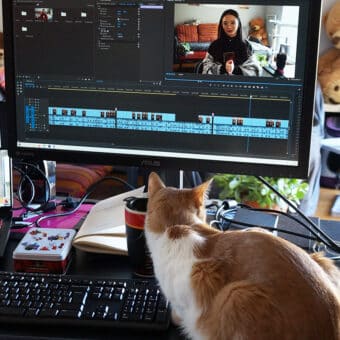Translated by my childhood friend Nguyen Viet Chau Linh
Part one:
The reality behind creative resolution and how to define it in a smart way
We are at the beginning of a new year. It’s the time to fix our resolutions, our motivation is at the highest point, we decide to go from scratch, we are ready to build a healthy basis for an exceptional year.
This is also the moment where some of us decide to make ONE creative resolution that would change our path, or even change our life.
“I’ll give myself one year for becoming a famous painter!”
“By the end of the year, I’ll became a professional composer!”
“This year I’ll do anything I could to build my actress career!”
Each new year, I hear (publicly or secretly) this kind of resolution filled with the hope of realizing one’s dream during a promising new year.
However, at the end of each year, the result is far from explosive. Most of these resolutions fail, and their holders continue their daily life with an unsolved objective.
We can keep repeating: “There is no failure, there’s only experiences”, however, at the moment when we realized that THE big resolution is not realized, we can’t help having a vacuum growing inside us.
Because this resolution is not only a box to check on a to-do-list.
It is a promise we made for ourselves, a dream, a potential solution to escape from a reality that doesn’t fulfill us anymore.
It is the opportunity to prove to ourselves and to other people close to us that we have the abilities, that we are serious, that we deserve it.
Sometimes, it is even a gambit: “One year to realize my dream, and after that, if there’s nothing, I’ll give up.”
That’s why we feel broken when the time goes by and we realize that our resolutions are fading away, wreaking havoc on our self-esteem.
I know too well this situation, because I am the first to take such resolutions, again and again, with more at stake, more hope, more fear, and less confidence each time.
- 2010, 16 years-old, I gave myself a year to prepare what I need in order to study at an art university and to become an artist.
- 2013, 19 years-old, I gave myself a year to look for an art training when I finished my technological college degree, and to begin my artist career.
- 2015, 21 years-old, I gave myself a year to interrupt my studies in engineering and to become an artist.
- 2018, 24 years-old, I gave myself a year to create as many artistic products as possible and to become an artist.
However, if you have followed my journey, you know that I only took the great leap forward in 2021! Each time my resolution failed, it was not due to a lack of ambition, discipline or motivation.
First big problem: This type of resolution is in fact a dream that need to be nourished with A LOT of resources.
To accomplish a resolution which would change our life is a process that needs time, energy, and money.
Did you check where you can find these resources?
“A year” might seems long, but during the whole year, will you have in mind only your resolution? Or do you also have familial, administrative, financial obligations?
In terms of budget, each person has his own spending that he can’t eliminate (rent, food, transport, health, birthday…). After removing this amount, how much do you have for your resolution?
You can apply the same thing for your time and your energy
Will you be able to overlook revisions, homework, exams in order to focus on your big resolution? Will you be able to say no to your community projects? Will you be able to modify your work hours? Will you be able to spend less time for your family? Will you be able to refuse diners with your colleagues after work?
And if we take a minute to answer the question: Why THIS resolution at THIS time precisely?
Because you’re near your 20s, you see your former high school classmates thriving in their creative projects, while you’re stuck in a monotone reality?
Because you’re near your 30’s and you can’t put up with this meaningless life?
Because you want to try for once?
Because at that same moment, you have the impression that everybody succeeded in this field and you can’t let go your opportunity?
Since it is your own resolution, nobody can judge the reasons. The important question here is “Why now?”. Is it the right time to fix this resolution? Isn’t is more relevant to free yourself from your obligations or somebody’s clutches, so that you can get the necessary resources before fixing such resolutions?
Fixing resolutions at January 1st is common, because this switch to a new year put us in an universal dimension. However, there’s no change after the night of 31st December to 1st January. Fixing THE big creative resolution in June or October (or in January in two years) won’t take away the value of your dream.
But even if, objectively, you feel like this is the right time to fix this resolution, the accomplishment remains difficult because we can’t ignore the second problem.
Second problem: The effectiveness of a creative resolution is subjective.
First of all, everything related to creation is difficult to measure. Also, we tend to think: “I’ll give myself a year and see how far I will go…”
However, if you haven’t defined what outcome you want to achieve, how do you know which direction to go? And then, how can you determine if the resolution is accomplished or not?
S.M.A.R.T.: A smart way to define your creative resolution
In 1981, George Doran defined 5 criteria for increasing the likelihood of realizing an objective.
Specific
If you want to become a successful composer at the end of the year, how do you define that success? By the number of followers on the social networks? By the number of contracts? By the profit you’ll get?
Measurable
Let’s say, you decide that being a successful composer means earning $ 50,000 per year from the purchase of your music. In that case, how many pieces of music should you sell per month?
Achievable
Will you have the necessary resources (time, equipment, staff, energy…) to produce the quantity of musical pieces you need? Will you be able to ensure that all productions would be sold at the price you have set?
Relevant
Would the price you set match your current level of skill, experience or reputation? Will you be willing to sell below this price?
Time related
According to the Parkinson’s Law, developed in 1955 by Cyril Northcote Parkinson in an article published in The Economist, your work hours would spread out to occupy the time available for its completion.
Generally, it is hard to tell when a creative product or project would be finished. If you don’t set a clear and realistic deadline for each step, you may get stuck in the details and never take the next step.
You can see that defining these 5 criteria requires numerical data.
The big trap lies in the third problem…
(To be continued)
The second part of the article, published on January 15, 2022: The big trap and the ultimate obstacle that prevents us from changing our life with our creative resolution
*Please consult the information on Copyright & Intellectual Property before copying or mentioning the content and images of tuhaan.com








